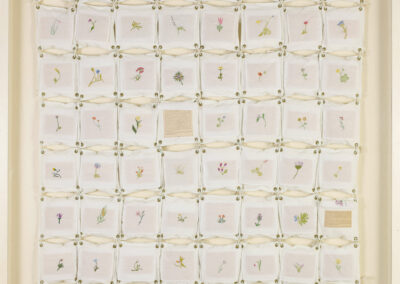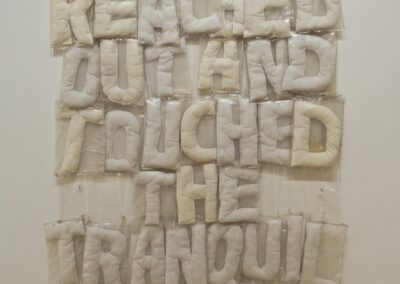Our next Artist You Need To Know is Joyce Wieland (1930 – 1988).
A painter, mixed media artist and filmmaker, Wieland began her career in Toronto in the 1950s before relocating to New York City in 1962. This spurred her to begin working with new materials (in both moving images and with non traditional media). While in the United States, Wieland also began to garner attention as an experimental filmmaker. She was an Officer of the Order of Canada (1982), awarded the Toronto Arts Foundation’s Visual Arts Award (1987) and a member of the Royal Canadian Academy of Arts.
Her exhibition True Patriot Love was the first solo exhibition by a living Canadian female artist at the National Gallery of Canada: this happened in 1971 and is recognized as a watershed moment in the annals of contemporary Canadian art, and the dialogues around it – or those conversations that are allowed around art and the Canadian art world. From the National Gallery’s own site: “[P]rovocateur Joyce Wieland challenged a staid, buttoned-down country to re-examine its values and reconsider its sense of national identity.”
Born in Toronto to parents that had immigrated from Britain, Wieland attended Central Technical School where she was influenced by one of her teacher, the artist Doris McCarthy. Wieland first solo exhibition was at the Isaacs Gallery in Toronto (1960): she broke ground as the only female artist represented by one of the most significant galleries in Toronto.
Wieland’s artwork was often unapologetically political, incorporating ideas of nationalism, war, ecology and feminism. But Wieland employed a wry humour more often than a heavy handed dourness in her practice. Curator Georgiana Uhlyarik, speaking about Wieland’s work at the AGO in an exhibition several decades after her death (a testament to Wieland’s importance) offers the following: “These works are a real reaction to what she was seeing around her. In the 1960s, Wieland had a political awakening. Having been locked out of the ‘boys’ club’ of the art world, she started using humour and popular culture to undermine patriarchy and capitalism.” (from here)
From 1956 to 1984 Wieland produced nearly twenty cinematic works (solo and sometimes in collaboration): on the international stage, she is best known as an experimental feminist filmmaker. “Her works introduced physical manipulation of the filmstrip that inscribed an explicitly female craft tradition into her films while also playing with the facticity of photographed images. Wieland’s output was small but received considerable attention in comparison to other female avant-garde filmmakers of her time. In the 1980s, Wieland focused again on painting, though her representation of the natural environment became less identifiably Canadian and her themes simply ones of nature, love and life.” (from here)
More about several of her significant film works can be found here: The Far Shore (1976) and Rat Life and Diet in North America (1968) are two of the more notable pieces Wieland produced.
In 1987, the documentary Artist on Fire (also known as Artist on Fire: Joyce Wieland or Artist on Fire: The Work of Joyce Wieland), directed by Kay Armatage, premiered at the International Women’s Festival of Film and Video (Montreal) and when shown at the 1987 Toronto International Film Festival was awarded an honorable mention for Best Canadian Film.
After her return to Toronto from NYC in the early 1970s, Wieland lived and worked actively there until her death at the age of 67, despite the fact that she had been diagnosed with Alzheimer’s in the 1990s.
Much more about Joyce Wieland’s life and work can be seen at the Art Canada Institute / Institut de l’Art Canadien with another of their fine online publications that offer both enjoyable and very considered profiles of Canadian artists you need to know – like Joyce Wieland.
Her work can be found in the collections of Agnes Etherington Art Centre, Museum London, Royal Ontario Museum, The Robert McLaughlin Gallery, Montreal Museum of Fine Arts, Ottawa Art Gallery, The Art Gallery of Hamilton and the National Gallery of Canada.
Johanne Sloan (author of Joyce Wieland: Life & Work) comments about Wieland’s life and legacy are erudite and insightful: “Despite the gravity of the issues she was addressing, Wieland’s humour was often in evidence as she set out to make political art. Drawing on foundations of Canadian visual culture, Wieland reminded her fellow citizens that the terms of the national contract should continue to be questioned.”
























